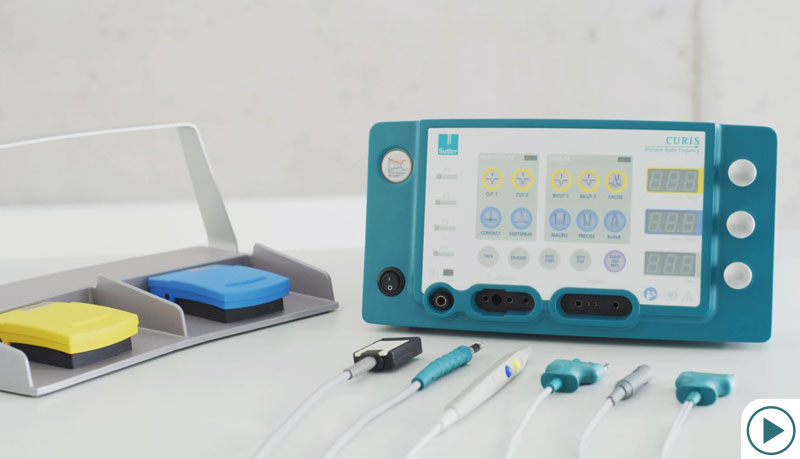CURIS® 4 MHz Radiofrequency Generator
The CURIS 4 MHz radiofrequency generator relies on innovative 4 MHz technology: It is gentle to the tissue and effective for coagulation, for submucosal shrinkage, and for cutting. Scientific studies have shown that tissue trauma may be reduced by using CURIS 4 MHz radiofrequency technology.*1
CURIS® 4 MHz Radiofrequency Technology
The higher the frequency, the less the resistance of biological tissue to electromagnetic fields – up to the point where cell membranes are capacitively coupled. This effect is created by the CURIS 4 MHz radiofrequency generator in all monopolar and bipolar modes. When using conventional electrosurgical units the electromagnetic field mainly concentrates between the cells and only heats up the outer layer. However, with the CURIS 4 MHz radiofrequency generator cell membranes are conductive, and energy is absorbed evenly inside the cells.*2 As a result, energy is administered gently and in a highly focused fashion. Precise monopolar cuts are possible while lateral heat damage is kept to a minimum.*3
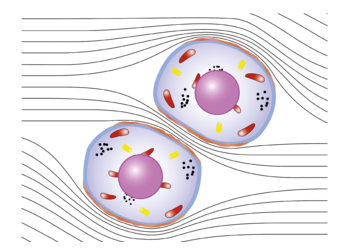
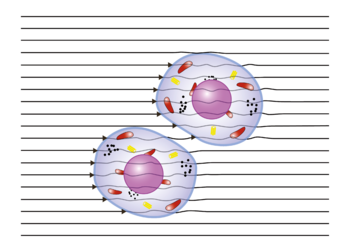
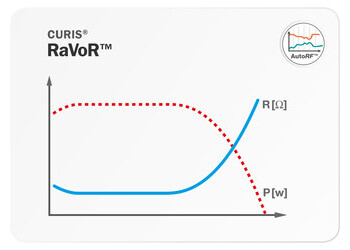
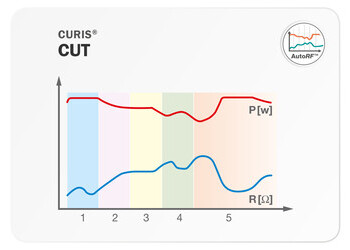
Precision thanks to AutoRF™
AutoRF is a smart impedance control function that will tailor the power output of the CURIS 4 MHz radiofrequency generator to the tissue condition. Whether it is cutting through different types of tissue (such as mucosa, muscle, fat or connective tissue) or altering tissue conditions during coagulation, the AutoRF feature will deliver adapted power output as required by the different tissue impedance.
When dissecting different types of tissue in one cut (skin, fat, muscles), the unit has to process and respond to the AutoRF data in a flash. For this reason, the CURIS 4 MHz radiofrequency generator has two microprocessors for additional safety and speed.
p3 Technology
p3, which stands for pulsed power performance, is active in all coagulation modes of the CURIS 4 MHz radiofrequency generator. Radiofrequency energy is delivered in about 50 small packages per second. Due to the pulsed power output, there are short breaks between the individual packages, giving the tissue enough time to absorb the energy. Highly focused, yet gentle coagulation with minimal thermal damage is possible.
Applications in ENT
The CURIS 4MHz radiofrequency generator offers many possibilities for a wide range of ENT indications. In our product catalog, you can find various examples for the different fields of ENT and head & neck surgery.
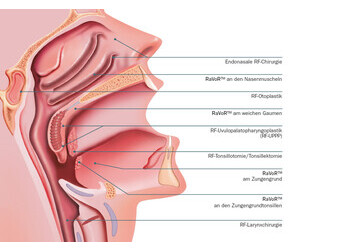
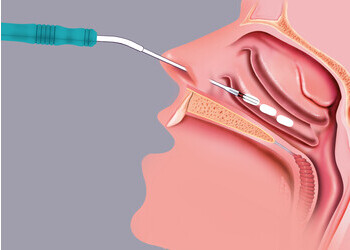
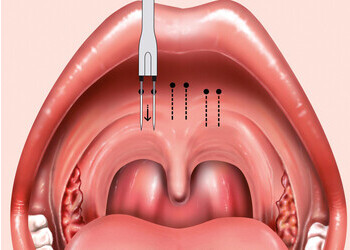
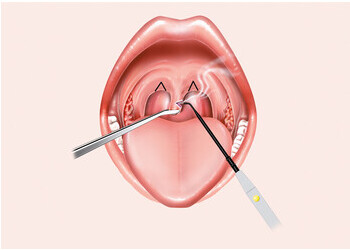
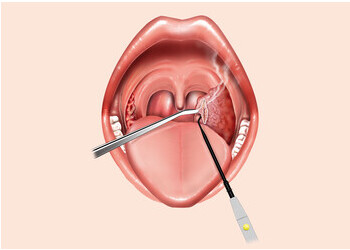
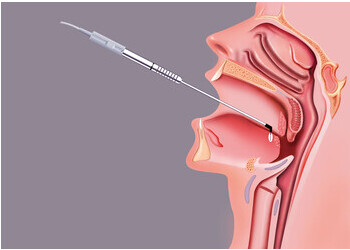
RaVoR™ Radiofrequency Volume Reduction
RaVoR of the inferior turbinates, soft palate, tongue base, etc. is an interstitial application for submucosal tissue shrinkage. Precise delivery of energy and smart power adjustment depending on actual tissue impedance aid in creating consistent and repeatable lesions. As soon as a suitable size of a lesion has been achieved, the CURIS 4 MHz radiofrequency generator will automatically stop the activation (AUTO STOP mode), and give an acoustic signal. The treated tissue is decomposed and transformed into fibrous scar tissue. This process leads to a shrinkage and stiffening of the treated area.
Sutter has developed different bipolar electrodes for the treatment of sleep - related breathing disorders based on the anatomical sites of obstruction.
Audio Feedback
If desired, an acoustic feedback function (AUDIO FEEDBACK) can be activated. While a lesion is created in RaVoR mode, the change in tissue condition is signaled by a changing pitch: The further the lesion progresses, the higher the activation sound. This mode may also be used to potentially increase the patient’s comfort. The patient will be able to listen and follow what happens inside the tissue.
"Bipolar radiofrequency volumetric tissue reduction, using Sutter technology, appears to have promising results for patients with snoring and mild OSA. One treatment session resulted in significant reduction in snoring intensity, improvement in sleep quality and QOL, and reduction of daytime sleepiness."
Pang et al. Sutter bipolar radiofrequency volume reduction of palate for snoring and mild obstructive sleep apnea. The Journal of Laryngology & Otology. 2009; 123: 750-754
Applications in Dermatosurgery and Plastic Aesthetic Surgery
Precise cutting allows the tissue to heal with minimal postoperative pain and scarring. The degree of hemostasis is determined by the surgeon. Usually CURIS 4MHz radiofrequency generator will produce clear, clean cuts. This only works when the energy delivered is highly focussed and there is minimal lateral heat damage. The frequency of 4 MHz and AutoRF combine to create a homogenous electromagnetic field. For the unit to adjust to ever changing conditions during cutting skin, fat, muscle in one stroke, active performance control with AutoRF is able to ensure reproducible results.
High quality coagulation results can be achieved, according to the doctor’s requirements, with two bipolar modes. For instruments with wider tips of 1 mm and more, the MACRO mode is recommended. The advantage of fine instruments – their precision – is enhanced by the PRECISE mode, which can be adjusted in steps of 0.5 watts. Its gentleness and characteristics may improve coagulation results during subtle interventions and near sensitive structures.
Further Information
For detailed information on applications and accessories, please refer to our product catalogs:
ENT and Head & Neck Surgery - Solutions with the CURIS® 4 MHz Radiofrequency Generator [1,8 MB]
Solutions for Skull Base Micro- and Neurosurgery [1,8 MB]
Advantages of the Impedance-Controlled 4 MHz Radiofrequency Technology [979 kb]
CURIS® 4 MHz Radiofrequency Generator and RaVoR™ Bipolar Electrodes single-use (EN) [1,0 MB]
CURIS® Basic Equipment Flyer (DE/EN) [128 kb]
CURIS Important Notes on Packaging [121 kb]
*1 Muehlfay G et al. A study on the type of lesions achieved by three electrosurgical methods and their way of healing. Romanian Journal of Morphology & Embryology. 2015; 56(4): 1383-1388
*2 Holder DS. Electrical Impedance Tomography - Methods, History and Applications. IOP Publishing Ltd. 2005
*3 Hoffmann TK et al. Comparative analysis of resection tools suited for transoral robot-assisted surgery. European Archives Oto-Rhino-Laryngology. 2014; 271 (5) : 1207-1213
*Disclaimer: Please note that this information video does not replace the products' instructions for use. Always refer to the instruction manual before operating a medical device.

; height: auto; },
(min-width: 501px) { src: url(https://www.sutter-med.de/chameleon/mediapool/thumbs/b/1f/CURIS-4-MHz-Radiofrequenz-Generator-Banner2_800x352-ID5158-5c0b094bad8bfc744f0e3b94e5f33e7a.jpg); height: auto; },
(min-width: 801px) { src: url(https://www.sutter-med.de/chameleon/mediapool/thumbs/b/1f/CURIS-4-MHz-Radiofrequenz-Generator-Banner2_1800x792-ID5158-ff2f3d3e915db10d966392821457525d.jpg); height: auto; }
)
